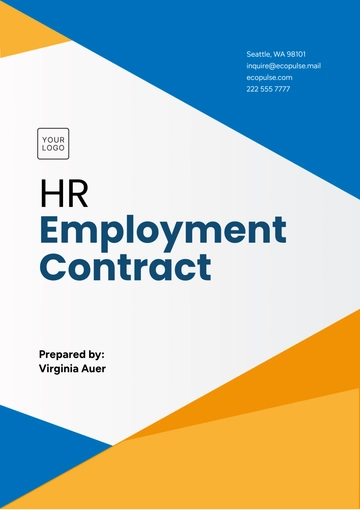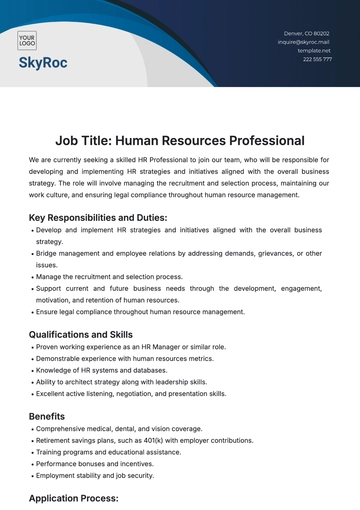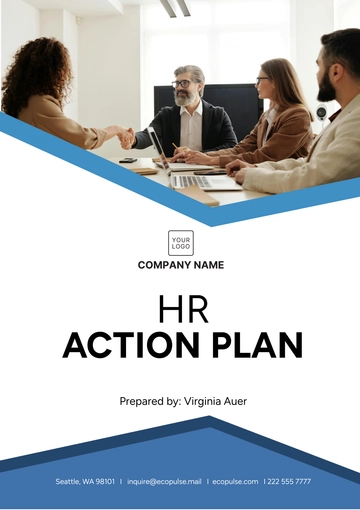Free HR Compliance Requirements

Prepared By: [YOUR NAME]
Date: [DATE]
I. Introduction and Purpose
The HR Compliance Requirements guide organizations to ensure adherence to employment laws and regulations. These requirements seek to foster ethical practices, protect employee rights, and ensure safe and fair workplaces. The objectives include compliance with legal standards, promoting a culture of fairness, and mitigating risks associated with non-compliance.
II. Legal and Regulatory Framework
Organizations must comply with a multitude of laws and regulations governing employment practices. These include, but are not limited to:
Equal Employment Opportunity (EEO) Laws: Ensure that hiring and other employment decisions are conducted fairly, without any bias related to race, color, religion, gender, national origin, disability, or age.
Occupational Safety and Health Administration (OSHA) Regulations: Ensure workplace safety by implementing hazard communication, providing protective equipment, and conducting employee training.
Family and Medical Leave Act (FMLA): Permits employees to take up to 12 weeks of unpaid leave each year for family or medical reasons, while ensuring job security and ongoing health benefits.
General Data Protection Regulation (GDPR): Regulates data privacy and protection for individuals in the EU, covering their rights to access, modify, and remove personal information.
Fair Labor Standards Act (FLSA): Establishes standards for minimum wage, overtime compensation, documentation, and youth labor to ensure equitable treatment and payment.
III. Policy and Procedure Guidelines
Category | Requirements |
|---|---|
|
|
|
|
|
|
IV. Roles and Responsibilities
Role | Responsibilities |
|---|---|
HR Manager |
|
Compliance Officer |
|
Department Managers |
|
Employees |
|
V. Training and Communication
To ensure compliance, it's necessary to implement thorough and well-organized training programs and to establish clear, consistent, and effective communication channels.
Mandatory Onboarding Training: Provide new employees with thorough onboarding that covers key compliance areas and company policies to ensure they understand their roles and responsibilities.
Annual Refresher Courses: Offer yearly refresher courses to update employees on compliance knowledge, new regulations, and company policies.
Regular Policy Updates: Regularly keep employees updated on policy changes and legal requirements using multiple communication channels to maintain their engagement and awareness.
VI. Monitoring and Reporting
Continuous monitoring and the implementation of a robust reporting mechanism play a crucial role in ensuring that compliance standards are consistently met over time.
Regular Compliance Audits: Perform routine audits to check adherence to compliance standards and identify issues.
Anonymous Reporting Channels: Ensuring employees have safe and anonymous channels for reporting violations or concerns is crucial so they feel protected and assured that their disclosures will not lead to retaliation or privacy breaches.
Timely Investigation and Resolution: Quickly investigate and resolve reported issues, ensuring effective corrective actions and communication.
VII. Audits and Reviews
To ensure that compliance is consistently upheld, it is essential to conduct regular audits and engage in routine reviews.
Annual Internal Audits: Conduct thorough internal audits each year to evaluate compliance with policies and regulations, and to identify areas for improvement.
Biennial Third-Party Reviews: Engage external auditors every two years to impartially assess compliance processes and recommend enhancements.
Implementation and Continuous Improvement: Act on audit findings promptly, implementing necessary changes and continuously improving processes to address any identified issues and adapt to evolving standards.
- 100% Customizable, free editor
- Access 1 Million+ Templates, photo’s & graphics
- Download or share as a template
- Click and replace photos, graphics, text, backgrounds
- Resize, crop, AI write & more
- Access advanced editor
Ensure HR compliance with Template.net's HR Compliance Requirements Template. This editable and customizable template helps you document and manage compliance requirements effectively. It covers all essential HR policies and procedures, ensuring adherence to legal and regulatory standards. Easily editable in our Ai Editor Tool, this template can be tailored to your organization's specific needs.





























